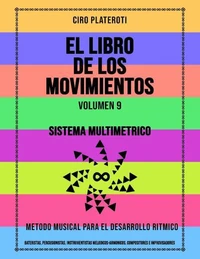The Book of Movements / Volume 5 / Palindromes 1
Par :Formats :
Disponible dans votre compte client Decitre ou Furet du Nord dès validation de votre commande. Le format ePub est :
- Compatible avec une lecture sur My Vivlio (smartphone, tablette, ordinateur)
- Compatible avec une lecture sur liseuses Vivlio
- Pour les liseuses autres que Vivlio, vous devez utiliser le logiciel Adobe Digital Edition. Non compatible avec la lecture sur les liseuses Kindle, Remarkable et Sony
 , qui est-ce ?
, qui est-ce ?Notre partenaire de plateforme de lecture numérique où vous retrouverez l'ensemble de vos ebooks gratuitement
Pour en savoir plus sur nos ebooks, consultez notre aide en ligne ici
- FormatePub
- ISBN978-1-005-61971-8
- EAN9781005619718
- Date de parution14/04/2022
- Protection num.pas de protection
- Infos supplémentairesepub
- ÉditeurC. C. Chamberlane
Résumé
IMPORTANT NOTICE: After practicing this 5th volume of The Book of Movements, You will notice changes in your self-perception since both hemispheres of the brain are exercised. Palindromes are movement patterns with certain special characteristics. Its internal components keep symmetrical distances They read the same from front to back and from back to front. These mirrored patterns are special in that when you practice themThey allow us to play fluidly with both hands, the same pattern.
Any pattern that is leading with the right hand is automatically played leading with the right hand.left, achieving a great kinesthetic balance. The palindromes sound very exotic and musical at the same time, there are all the movement patternspalindromics that exist in metric 3/8; 4/8; 5/8; 6/8; 7/8; 8/8; 9/8; 8/10; 11/8; 12/8; 8/13; 8/14; 8/15 and 8/16Irregular metrics with these patterns sound amazing.
The focus of this volume I is with the accentuation technique. In addition to the thousands of patterns, the book contains different approachesto give them interesting musical treatments that will make your head explode. Many of us hear about palindromes in poetry through phrases or words, in mathematics through numbers, we also hear that the human genome has palindromic sequences etc. Although there are already compositions, melodies and resources used by great composers in the history of music, related to this kind of symmetry, it turns out that the infinite potential that these special sequences have on musical situations where they can be applied in different ways is little explored.
in a very organic way. This method has specifically selected palindromic movement patterns and classified in a compilationof which there are no antecedents in musical history. It is aimed at those who play drums, percussion, piano, bass, guitar, Hang, body percussion orinstrumentalists looking to create new musical ways of approaching their instrument, alsoprovides excellent rhythmic forms for composers and improvisers.
The palindromes here are arranged in patterns with metrics ranging from 3 to 16 beats, soWe will explore this type of patterns in 14 different metrics, with a simple, organic visual approach.auditory and kinesthetic learning. Palindromic sequences exist in different languages of nature, and of course, alsothey are present in music, both in the harmonic and melodic plane as well as in the rhythmic plane.
Such sequences visually produce a symmetric phenomenon of reflection that is also veryeasy to appreciate from an auditive aspect when we listen to the call and the response, which carriesthe palindrome itself. That call and response (object and reflection) give us a very clear notionthat we are listening to a well-formed musical phrase.(Many of us have already played palindromic several times without being aware of it)On the other hand, palindromes (here called palindromic motives) while wonderful, sincea musical discursive aspect are also in the motor aspect.
It turns out that the human body, seen from the outside, has palindromic shapes from acentral axis of symmetry towards the ends and from the ends to the axis again. This type of symmetry manifested naturally in our body, raises its potentialand these can be explored very organically with the movements proposed by thepalindromic sequences contained in this book, enhancing our kinesthetic awareness.
Any pattern that is leading with the right hand is automatically played leading with the right hand.left, achieving a great kinesthetic balance. The palindromes sound very exotic and musical at the same time, there are all the movement patternspalindromics that exist in metric 3/8; 4/8; 5/8; 6/8; 7/8; 8/8; 9/8; 8/10; 11/8; 12/8; 8/13; 8/14; 8/15 and 8/16Irregular metrics with these patterns sound amazing.
The focus of this volume I is with the accentuation technique. In addition to the thousands of patterns, the book contains different approachesto give them interesting musical treatments that will make your head explode. Many of us hear about palindromes in poetry through phrases or words, in mathematics through numbers, we also hear that the human genome has palindromic sequences etc. Although there are already compositions, melodies and resources used by great composers in the history of music, related to this kind of symmetry, it turns out that the infinite potential that these special sequences have on musical situations where they can be applied in different ways is little explored.
in a very organic way. This method has specifically selected palindromic movement patterns and classified in a compilationof which there are no antecedents in musical history. It is aimed at those who play drums, percussion, piano, bass, guitar, Hang, body percussion orinstrumentalists looking to create new musical ways of approaching their instrument, alsoprovides excellent rhythmic forms for composers and improvisers.
The palindromes here are arranged in patterns with metrics ranging from 3 to 16 beats, soWe will explore this type of patterns in 14 different metrics, with a simple, organic visual approach.auditory and kinesthetic learning. Palindromic sequences exist in different languages of nature, and of course, alsothey are present in music, both in the harmonic and melodic plane as well as in the rhythmic plane.
Such sequences visually produce a symmetric phenomenon of reflection that is also veryeasy to appreciate from an auditive aspect when we listen to the call and the response, which carriesthe palindrome itself. That call and response (object and reflection) give us a very clear notionthat we are listening to a well-formed musical phrase.(Many of us have already played palindromic several times without being aware of it)On the other hand, palindromes (here called palindromic motives) while wonderful, sincea musical discursive aspect are also in the motor aspect.
It turns out that the human body, seen from the outside, has palindromic shapes from acentral axis of symmetry towards the ends and from the ends to the axis again. This type of symmetry manifested naturally in our body, raises its potentialand these can be explored very organically with the movements proposed by thepalindromic sequences contained in this book, enhancing our kinesthetic awareness.
IMPORTANT NOTICE: After practicing this 5th volume of The Book of Movements, You will notice changes in your self-perception since both hemispheres of the brain are exercised. Palindromes are movement patterns with certain special characteristics. Its internal components keep symmetrical distances They read the same from front to back and from back to front. These mirrored patterns are special in that when you practice themThey allow us to play fluidly with both hands, the same pattern.
Any pattern that is leading with the right hand is automatically played leading with the right hand.left, achieving a great kinesthetic balance. The palindromes sound very exotic and musical at the same time, there are all the movement patternspalindromics that exist in metric 3/8; 4/8; 5/8; 6/8; 7/8; 8/8; 9/8; 8/10; 11/8; 12/8; 8/13; 8/14; 8/15 and 8/16Irregular metrics with these patterns sound amazing.
The focus of this volume I is with the accentuation technique. In addition to the thousands of patterns, the book contains different approachesto give them interesting musical treatments that will make your head explode. Many of us hear about palindromes in poetry through phrases or words, in mathematics through numbers, we also hear that the human genome has palindromic sequences etc. Although there are already compositions, melodies and resources used by great composers in the history of music, related to this kind of symmetry, it turns out that the infinite potential that these special sequences have on musical situations where they can be applied in different ways is little explored.
in a very organic way. This method has specifically selected palindromic movement patterns and classified in a compilationof which there are no antecedents in musical history. It is aimed at those who play drums, percussion, piano, bass, guitar, Hang, body percussion orinstrumentalists looking to create new musical ways of approaching their instrument, alsoprovides excellent rhythmic forms for composers and improvisers.
The palindromes here are arranged in patterns with metrics ranging from 3 to 16 beats, soWe will explore this type of patterns in 14 different metrics, with a simple, organic visual approach.auditory and kinesthetic learning. Palindromic sequences exist in different languages of nature, and of course, alsothey are present in music, both in the harmonic and melodic plane as well as in the rhythmic plane.
Such sequences visually produce a symmetric phenomenon of reflection that is also veryeasy to appreciate from an auditive aspect when we listen to the call and the response, which carriesthe palindrome itself. That call and response (object and reflection) give us a very clear notionthat we are listening to a well-formed musical phrase.(Many of us have already played palindromic several times without being aware of it)On the other hand, palindromes (here called palindromic motives) while wonderful, sincea musical discursive aspect are also in the motor aspect.
It turns out that the human body, seen from the outside, has palindromic shapes from acentral axis of symmetry towards the ends and from the ends to the axis again. This type of symmetry manifested naturally in our body, raises its potentialand these can be explored very organically with the movements proposed by thepalindromic sequences contained in this book, enhancing our kinesthetic awareness.
Any pattern that is leading with the right hand is automatically played leading with the right hand.left, achieving a great kinesthetic balance. The palindromes sound very exotic and musical at the same time, there are all the movement patternspalindromics that exist in metric 3/8; 4/8; 5/8; 6/8; 7/8; 8/8; 9/8; 8/10; 11/8; 12/8; 8/13; 8/14; 8/15 and 8/16Irregular metrics with these patterns sound amazing.
The focus of this volume I is with the accentuation technique. In addition to the thousands of patterns, the book contains different approachesto give them interesting musical treatments that will make your head explode. Many of us hear about palindromes in poetry through phrases or words, in mathematics through numbers, we also hear that the human genome has palindromic sequences etc. Although there are already compositions, melodies and resources used by great composers in the history of music, related to this kind of symmetry, it turns out that the infinite potential that these special sequences have on musical situations where they can be applied in different ways is little explored.
in a very organic way. This method has specifically selected palindromic movement patterns and classified in a compilationof which there are no antecedents in musical history. It is aimed at those who play drums, percussion, piano, bass, guitar, Hang, body percussion orinstrumentalists looking to create new musical ways of approaching their instrument, alsoprovides excellent rhythmic forms for composers and improvisers.
The palindromes here are arranged in patterns with metrics ranging from 3 to 16 beats, soWe will explore this type of patterns in 14 different metrics, with a simple, organic visual approach.auditory and kinesthetic learning. Palindromic sequences exist in different languages of nature, and of course, alsothey are present in music, both in the harmonic and melodic plane as well as in the rhythmic plane.
Such sequences visually produce a symmetric phenomenon of reflection that is also veryeasy to appreciate from an auditive aspect when we listen to the call and the response, which carriesthe palindrome itself. That call and response (object and reflection) give us a very clear notionthat we are listening to a well-formed musical phrase.(Many of us have already played palindromic several times without being aware of it)On the other hand, palindromes (here called palindromic motives) while wonderful, sincea musical discursive aspect are also in the motor aspect.
It turns out that the human body, seen from the outside, has palindromic shapes from acentral axis of symmetry towards the ends and from the ends to the axis again. This type of symmetry manifested naturally in our body, raises its potentialand these can be explored very organically with the movements proposed by thepalindromic sequences contained in this book, enhancing our kinesthetic awareness.






















